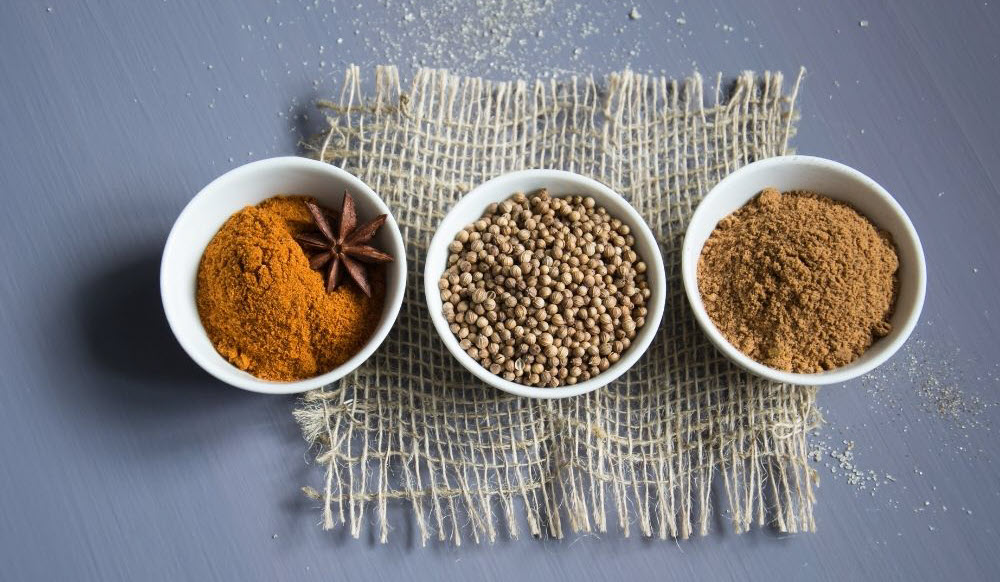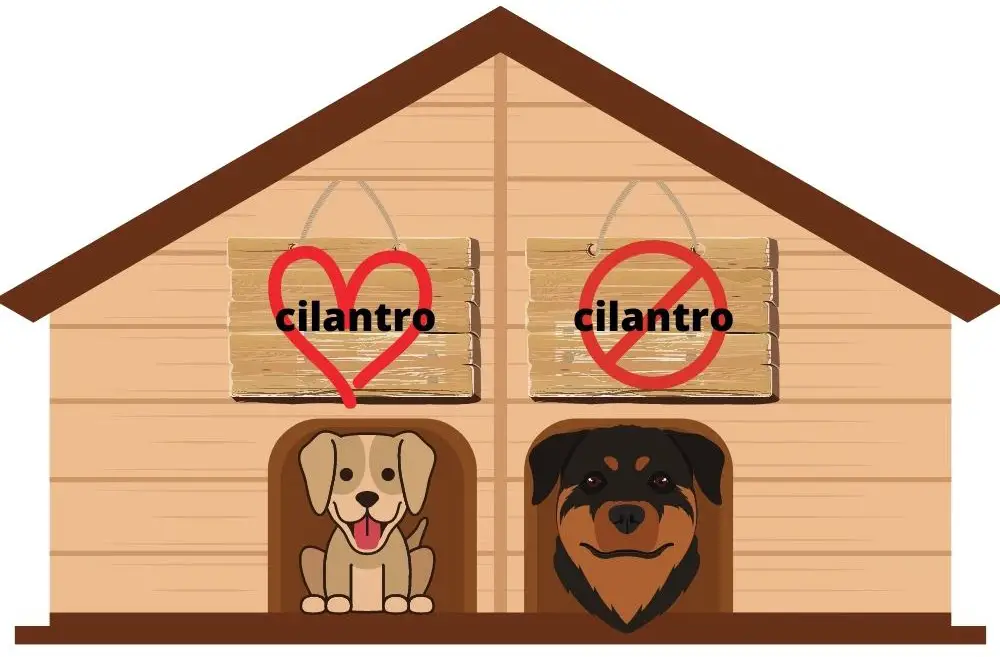Let’s get this out of the way up front. Cilantro is non-toxic for dogs, so it is safe for your dog to eat cilantro. It’s unlikely they’ll eat enough to pose a problem, so unless you are feeding your dog bushels of cilantro, the answer to “Can dogs eat cilantro” is yes, absolutely they can.
The real question is, “Should they?”.
Does cilantro really belong in a dog’s diet?
For more information about what your dog should and should not eat, be sure to take a look at our “Can dogs eat…” article where we cover over 80 different items.
What is cilantro
My wife and I differ on this opinion.
I believe it’s nasty, soap-tasting green stuff she puts into her food.
She believes it’s a tasty, nutritious fresh herb I should put into my food.
We’re a house divided.
It seems I’m one of the 10% or so of the human population that thinks cilantro tastes like soap. The other 90% tend to love the taste. This baffled the scientific community for a long time, but they think they understand the reason now.
I can argue that I’m in good company here. Julia Child can’t stand the taste, either.
I bring this up because if your dog doesn’t like the taste, science may have an answer for dogs as well. If one dog likes it and another doesn’t, you may end up with a (dog)house divided.
The plant species is Coriandrum Sativum, a green, leafy herb in the Apiaceae family (also known as the carrot, parsley, or celery family). It has a strong aroma and a taste you love or hate. There are three parts of the plant to consider – the leaves, the stems, and the seeds.
Cilantro refers to the leaves and stems, while the dried seeds are called coriander. Each has a different taste and nutrition profile. You’ll find cilantro as fresh leaves or dried.
These names are regional, so depending on where you are or what you read, you may see the leaves and stems referred to as Coriander and the seeds called Coriander seeds.
Speaking of names, you may also see cilantro referred to as Chinese parsley due to its popularity in Asian dishes.
Should I feed my dog cilantro?
Ok, so it’s safe to feed my dog cilantro, but you said the real question is, “Should I feed my dog cilantro.”
Here’s the deal – the dog food your dog eats contains all of the vitamins and nutrients your dog needs and is in the correct ratios. So you should not need to add anything else to your dog’s diet for its health.
We have other articles that discuss, for instance, feeding bell peppers, jicama, or other fruit/vegetables to dogs because of the health benefits.
Both are safe to feed dogs, extremely nutritional, and yet – again – if you are feeding your dog the right dog food, you don’t need to feed them bell peppers, or cilantro, for the health benefits.
In this specific example, a few slices of bell peppers make for a great snack or training aid, so it’s slightly different than cilantro, which you would only add to dog food rather than feeding as snacks or dog treats.
So should you feed your dog cilantro? I’d say there’s little reason to. But, in small amounts, there’s also little risk in doing so.
Nine health benefits your dog may gain by eating cilantro
The health benefits humans derive from eating cilantro are extensive. It is a herb that packs a lot of nutritional punch. From a nutritional standpoint, cilantro ranks up there with the most powerful herbs.
History shows that Hippocrates, the father of medicine, strongly advocated its use over 2,000 years ago.
Who am I to argue with Hippocrates?
Do dogs get the same benefit from cilantro as humans?
There is debate over whether your dog derives the same benefits from cilantro as humans.
If you intend to feed your dog cilantro to improve your dog’s health, you may be wasting your time as the amount you’ll feed your dog is probably insufficient to have tangible effects.
If you intend to understand if it’s OK for your dog to eat human food with cilantro, then yes – the cilantro in your table scraps is fine for your pooch. The more important question is, what else is in those table scraps?
You should compare the vitamin content in cilantro (and indeed any non-dog food or snack you consider giving your dog) against what they get from their dog food. Yes, cilantro is high in vitamin A, as is dog food. Importantly, dog food (for the most part) has the vitamins the dog needs in the correct ratios.
For example, too much vitamin A is harmful to dogs. How do you give your dogs human food and, at the same time, ensure you’re not giving too much of something?
The below health benefits apply to humans and may also apply to dogs, but, again, it will depend on how much cilantro they actually eat and how much benefit they derive.
- Improved digestion
Cilantro may help keep your dog regular, ensure an efficient digestive system, and improve the efficiency of the assimilation of nutrients your dog eats. It can also help with gas, upset stomach, or other digestive issues.
- Healthy fur, strong bones, and teeth
Cilantro is famous for its high amount of vitamin K, which may support strong teeth and bones and a healthy coat. Improved calcium absorption may ensure your puppy’s fur is healthy and its bones and teeth grow and remain strong.
- Healthy brain
Animal studies indicate that cilantro’s anti-inflammatory properties can safeguard against cognitive degeneration, helping your furry friend maintain its mental facilities into old age.
- Canine Diabetes
In humans, cilantro has been shown to regulate blood sugar levels and can be used to help combat diabetes.
- Strong immune system
The vitamin C in cilantro contributes to creating and maintaining a strong immune system, protecting against sickness.
- Healthier Blood
The iron content in cilantro may help keep your dog’s blood healthy and elevate the capacity to carry oxygen to its brain.
- Enhance your dog’s calm
Studies show that there is a calming effect associated with eating cilantro that is similar to taking Valium. However, this requires high doses, so it’s unlikely (and not suggested) to feed that much to your dog all at once, but continual doses over time may have an accumulative effect.
- Overall health
This final point is a bit of a catch-all in that the carotenoids found in cilantro are powerful antioxidants. These may improve various areas, including eye disease, inflammation, specific cancers, arthritis, macular degeneration, etc.
- Dog breath
Ok, your dog’s breath isn’t really a “health” benefit, but it’s worth discussing. It’s popular to crush up cilantro before using it in a dish. When you do this, you’ll be treated to a wonderful aroma. Even I, one of those that don’t care for the taste, appreciate the smell of crushed cilantro. Reminds me of Mexican restaurants. Feeding your dog crushed cilantro can have a (usually small) impact and somewhat improve its bad breath.
Three risks your dog faces from eating cilantro
Too much of a good thing is often not a good thing. This applies to humans but even more to dogs.
As mentioned above, vitamin A is a good thing. We all need it. It promotes better eye health and, therefore, better eyesight.
But too much isn’t safe for your pooch.
Does it make sense to give your dog cilantro because it provides vitamin A, or does it make more sense to give your dog the right dog food with vitamin A and all other vitamins and nutrients in the correct ratios?
We recommend the latter. Feed your dog the right dog food; you don’t need to worry about supplementing with human-healthy or human-tasty foods and snacks.
- Vitamin overdose
I’ll make the point here again. Your dog’s food should contain all of the vitamins, minerals, and nutrients your dog needs and, importantly, in the correct ratio. Therefore, feeding your dog anything with high vitamin content, for example, can give your dog too much of that vitamin. You likely won’t be feeding your dog enough cilantro to cause a problem, but caution is still advised.
- Allergic reaction
Dogs can be finicky creatures. Some dogs may be allergic to cilantro, so if you need to feed them cilantro, start in small doses to check for signs of allergies. Obviously, if you see any, this should end your cilantro experiment.
- Upset stomach, diarrhea, vomiting
Cilantro is high in fiber, so keep this in mind. You probably won’t be feeding your dog enough to matter, but again, you are adding fiber to a feeding regimen that (should) already have enough fiber. Tread carefully.
Cilantro leaves, powder, and seeds. Which should I feed my dog?

Cilantro is an interesting plant in that the leaves, stems, and seeds all have different taste and different nutritional profiles.
The leaves and stems tend to have citrusy flavors, while the seeds lean towards a nutty taste. Those who do not like the taste of cilantro leaves may still like the cilantro seeds, known as coriander.
Because of the flavor, the leaves and the seeds are not interchangeable in recipes, not that you are probably looking that deeply into cooking for your dog.
If you are feeding your dog cilantro for health benefits, it makes sense to feed the leaves and the seeds.
How much cilantro should I feed my dog?
Not much.
Not much at all.
Crush and sprinkle maybe one-half to one tablespoon of this fresh herb into your dog’s meal if it’s a large dog. Maybe a quarter or a half of a teaspoon of crushed cilantro is fine for small dogs.
Start small, as recommended earlier, to ensure no allergic or other adverse reactions.
And remember, your dog may not like the taste!
Should cilantro be cooked or raw for my dog to eat?
Raw makes sense. Crush it up, and mix it in with their food.
Cilantro is normally added after a dish is cooked. It is sprinkled on top for decoration and gives a dish some extra flavor.
In some countries, large amounts of cilantro are added to dishes while cooking. This gives the dish a deeper and more robust cilantro taste. However, crushing and mixing in with the food is fine for your pooch.
Will my dog like cilantro?
Hard to say. As mentioned earlier, about 10% of the human population thinks it tastes like soap. That official number is actually 4-14%, statistically. However, the scientific reasons behind that are genetic, so it’s unlikely, it also extends to dogs.
Most likely, you’ll find your dog will scarf down its food whether you’ve mixed in a small amount of cilantro.
In conclusion: Can dogs eat cilantro?
Yes, they can. But, as mentioned previously, should they? If you are feeding your dog cilantro for its health benefits, we recommend finding a top-rated dog food that offers the same benefits. This is the better approach as you know your dog will get the correct ratios, which is critical. If your dog has bad breath, there are specific chew toys and snacks to address this.
We often hear, “Can dogs eat [fill in the blank]” so we are working on a series of articles to discuss these topics. Please see our additional articles on our main dog health page.
Also, for a more informative overview about what your dog should and should not eat, look at our “Can dogs eat…” article, where we cover over 80 different items.

